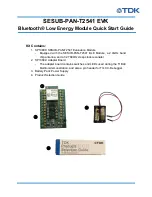
USB Data Link Adapter
26
Appendix B
8.
Appendix B
8.1.
Automotive Networks
Automotive information networks will not communicate with standard computer
interfaces. PCs use parallel, RS232 serial, and USB ports, while engine controllers
and instrument panels typically use J1708, J1850 and J1939. These are automotive
network standards defined by the Society of Automotive Engineers (SAE). PC ports
and automotive networks use different voltage levels, data rates and check sums. An
adapter is required to connect the laptop and engine together, this is where the DLA
comes into play. The DLA supports CAN (Controller Area Network) and the J1708
and J1939 automotive networks.
8.1.1.
J1939
In the 1980's Bosch developed a system called Controller Area Network (CAN). CAN
was intended to be used as a communication network for industrial controllers. It
has gained acceptance in a wide variety of markets including the automotive
industry. CAN hardware ports are now embedded in micro-controllers. J1939 is a
standard developed by the Society of Automotive Engineers (SAE) that defines how
information is passed on a CAN network. J1939 is a differential pair network using
CAN Transceivers in a dominant/recessive mode. The network cable is terminated
on each end by a 120
resistor. The maximum data rate is 250Kbps. The data packet
format is <PGN><8 DATA BYTES><CRC>.
8.1.2.
J1708
J1708 is an automotive network developed by SAE about the same time as CAN.
J1708 is a differential pair network using standard RS485 drivers in a
dominant/recessive mode. J1708 is terminated by 4.7K
pull-up / pull-down and
47
series resistor. The data format and rate is the same as the standard computer
serial port: 9600bps, 1 start bit, 8 data bits, 1 stop bit. The data packet format is
<MID><PID><DATA><PID><DATA><CHK>.
8.2.
RP1210 Compatibility
RP1210 was developed by the Technology and Maintenance Council (TMC) of the
American Trucking Association (ATA) to address issues in servicing vehicles
manufactured by different vendors. Service personnel were forced to purchase an
expensive DLA to communicate with each different type of vehicle and engine.
RP1210 provides a consistent application interface so that the same DLA hardware
can be used with many different applications. If software developers follow the
RP1210 standard, then their engine diagnostic software should work a DLA from any
manufacturer. Parker Vansco's industry standard RP1210 API is ve121032.dll.
Parker has made every effort to make the USB-DLA RP1210 compliant. It should be
usable with test tools from Dearborn, Cummins, and other manufacturers. We







































